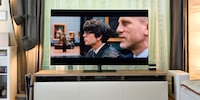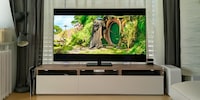

QD OLED: Samsung's TV of the future is fantastic
The comeback of the year: Samsung is building OLED TVs again after almost ten years - and is only developing them further. QD-OLED is the name of the new technology. And the coup succeeds.
It was like a medium-sized earthquake when Samsung let the cat out of the bag at CES 2022, the world's largest tech trade fair: This year, the South Korean tech giant plans to launch its first marketable OLED TV. And not just any TV. But a further development of OLED technology: QD OLED. With the S95B, the promise has finally been fulfilled.
The "QD" in QD-OLED stands for Samsung's Quantum Dots. These not only make for nicer colours, but are also supposed to increase the TV's maximum brightness - especially by otherwise rather modest OLED standards. This could shift the balance of power in the OLED market, which has so far been dominated by LG. Even if no manufacturer would admit it: It is an open secret that Sony, Philips and Panasonic buy their OLED panels from LG Display.
Will that change soon? Sony has already struck once, ordering from Samsung for their A95K. Now Samsung's device is also available with their in-house panels. Finally. Because the S95B is a delight.
Design top, but: no One-Connect-Box
Samsung talks about a "laser-thin" design. In fact, the screen is crazy thin: I measured just 0.4 centimetres. Hammer. At least at the top. Typical for (QD) OLED. A little further down the panel, where hardware components such as the processor, motherboard and connections are installed, the TV measures about 3 centimetres. Still thin.
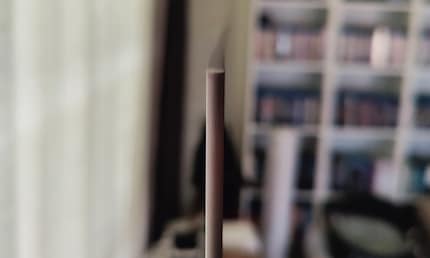
Other than that, Samsung stays true to its design this year: modern, slim, narrow edges - and no frills. The TV is held together by a classy aluminium frame at the front and a less classy plastic cover plate at the back, which hides the connections and helps with cable routing. In addition, as with the 2022 Neo QLED QN95B, there's the curved, wafer-thin, silver stand in the centre of the panel. It is hardly noticeable. On the other hand, it leaves about 7 centimetres of space between the panel and the TV furniture. Perfect for a soundbar.
However, there is one thing I miss: the One-Connect-Box, which is common on Samsung's top models. What is that? A small box that replaces the connections built into the panel. Only a single, inconspicuous cable connects the box to the TV and supplies power as well as video and audio signals. This eliminates the possibility of having not only the box but also the entire cable tangle disappear elegantly into a drawer of your TV furniture. Of all things, this is the slimmest TV Samsung has ever built. After all, the thin set cries out for wall mounting - and thus for a one-connect box.
A shame, Samsung, a real shame.
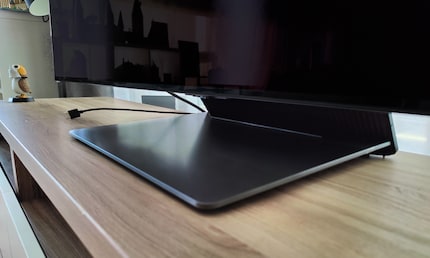
Onto the connections. There are:
- 4× HDMI 2.1 ports (4K120Hz, ALLM and VRR)
- One of them with eARC (HDMI 3)
- 2× USB 2.0 ports
- 4× antenna inputs
- 1× output for Toslink
- 1× LAN port
- 1× CI+ 1.4
- Antenna and satellite connections
- Bluetooth (BT 5.2)
All four HDMI inputs support HLG, HDR10 and HDR10+. Still a major Samsung shortcoming: Dolby Vision is not supported. Dolby Atmos is supported, including passthrough if you forward the sound to an external sound system. DTS audio, on the other hand, is not available. Not even via passthrough. DTS formats are instead played back and passed on as lower-quality multichannel PCM 5.1 audio.
The 65-inch version of the TV provided to me by Samsung is a relatively light 25.5 kilograms. If you want to mount the TV on the wall - it weighs 21.2 kilograms without the stand - you need a VESA 300×200mm mount. You can find this here in our shop
.
QD-OLED in a Nutshell
To explain QD-OLED to you properly, it would actually take a whole article. Well, I already wrote that one. If that's too long for you, here's the shorter form. If you just want to know how good the S95B is, you can skip all that and go to the chapter "Measurements: Samsung's QD OLED is impressive".
First things first: Before I can explain QD-OLED to you, you need to know why OLED is considered the best imaging technology in the display market. The special thing about OLED pixels is that they not only generate the image, but also their own light. LCD pixels cannot do that. This has a big impact on the picture quality. I have also written about this:
The decisive advantage of OLED is the display of true black - and the associated better contrasts. On the other hand, OLED pixels shine less brightly than conventional LEDs. This is due to their light-absorbing colour filters: If OLED TVs were to shine brighter as compensation - supplying more energy to the pixels - more heat would develop. This, in turn, would accelerate the wear of the material and lead more quickly to burn-in. That's unsightly, ghostly image residue, which I explained here once.
LG was the first manufacturer years ago to find a way to improve screen brightness without significantly increasing the risk of burn-in: by adding an extra white sub-pixel to the pixel architecture. Until then, a pixel consisted only of a red, blue and green subpixel. Since then, the white subpixel has provided more brightness. At the same time, it reduces the energy load per subpixel and thus the risk of burn-in. On the other hand, the white subpixel tends to bleach out the other colours. Not that OLED colours are bad because of this. Quite the contrary. But they do not exploit the full potential.
The name of this technology: WOLED.
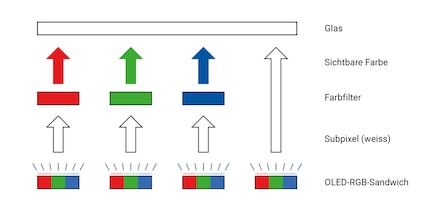
And now comes Samsung's QD OLED. What's different about it? The namesake Quantum Dots. Shown in the graphic below as the QDCC layer. Hence QD-OLED. Put very simply, Samsung's Quantum Dots do not filter. They colourise. That is the crucial difference. Light is lost when filtering. Quantum Dots, on the other hand, change the wavelength of the light, and thus its colour. Samsung's QD OLED technology therefore does not need an additional white subpixel to artificially provide more brightness - and thus also solves the problem of the bleaching white subpixel.
A small change - with a potentially huge effect.
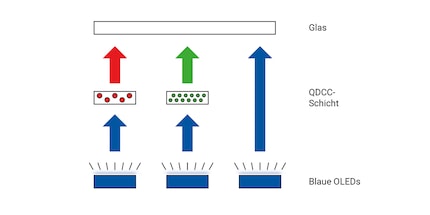
Source: Sven Mathis
Summa summarum: Samsung exploits more potential from the OLED pixels with its QD layer than LG. They shine brighter and more powerfully. With the same energy input. That is also important. We remember: more energy equals more heat equals higher burn-in risk. No wonder manufacturer Sony wants to jump on the QD OLED bandwagon.
Measurements: Samsung's QD-OLED is impressive
What comes next goes even deeper than the QD-OLED explanation above. If tables and diagrams don't interest you, you can skip all that and scroll straight to the chapter "The picture: powerful yet natural". From there on, you'll find my subjective impressions with lots of video material.To the measurements. Of course, I could only show filmed or photographed displays and point out strengths and weaknesses. In the end, I would only reflect my subjective feeling. But how bright, natural and accurate a television actually is can also be measured in numbers. That has one advantage: numbers are more objective than I am.To bring you this new service - so far it's only available on my reviews of Samsung's 2022 Neo QLED (QN95B) and Sonys 2022 QD-OLED (A95K) - we in the editorial professional tool purchased from Portrait Displays.I measured out all the screen modes of the TV. From "Brilliant" to "Standard" to "Film", without calibration or manual changes in the settings. Just like most normal people use a television. After all, you want to buy a TV that is already as accurate and true to colour as possible out of the box and without expensive and professional calibration. The only thing I have turned off are the sensors for automatic brightness. They are a pain. The best values for all types of content - except gaming, of course - were achieved in "Filmmaker" mode.The measurements listed below therefore refer to "Filmmaker".### The maximum brightnessThe brightness is important for the TV for two reasons. On the one hand, it influences the contrast value. It determines how many different colours a TV can display. On the other hand, brightness is important if you often watch TV during the day in rooms flooded with light. If a TV is not bright enough, it can be outshone by the ambient light in the room. The picture will then look rather pale to you.Let's look at the brightness of the S95B. In the graph, I compare it directly with Sony's A95K, which uses the same QD OLED panel.[[iframe:src=https://flo.uri.sh/visualisation/10813062/embed]] Nit is the English unit of measurement for candela per square metre (cd/m²), i.e. luminance or brightness. 100 nits correspond approximately to the brightness of the full moon in the night sky.There are two axes: the vertical stands for brightness, the horizontal for the section in which the brightness is measured. At two per cent of the entire screen surface, i.e. selectively and with very small image areas, Samsung's QD-OLED achieves an insanely high luminance value of 1011 nit by OLED standards. And that's in Filmmaker mode, which tends to be a little darker than the TV's "Standard" or "Brilliant" modes.The comparison with Sony's A95K is interesting. Although it has the same panel, the Samsung is slightly brighter overall, both at specific points and across the entire screen. This shows once again that just because panels come from the same factory, they do not necessarily produce the exact same image. Much more decisive is how the individual pixels are controlled. That, in turn, is primarily a question of the processor. I will come to that, below, in the chapter "Processor".[[image:65762115 "When measuring the brightness, white sections of the display of different sizes are measured one after the other. Here: a section as large as ten percent of the entire screen area. "]]Another comparison that illustrates how bright the 1011 nit is: About 700 nit would be usual for OLED TVs, and that too only with picture settings aimed at maximum brightness, which has nothing to do with natural colours. Only LG's Evo panel, which is only used in LG OLED TVs, can keep up to some extent. In most tests last year, it came in at around 850 nit.Significantly less superior is the overall brightness of the QD OLED TV at full window size: 211 nit. True, that would be a lot for an OLED TV; LG's Evo panel came in at 170 nit last year. But LCD TVs still shine much brighter here. Samsung's QN95B, for example, at 658 nit.What does this tell us? If you put a QD OLED TV next to an OLED TV, you won't notice much difference in terms of brightness. On the other hand, the maximum brightness in very selective picture areas anticipates better contrast values and thus more displayable colours..### The white balanceWhat exactly does white actually look like? That depends on the colour temperature. On the warmth or coldness of white. Warm tends towards yellow/orange. Cold tends towards blue. This in turn affects the representation of colours. In the industry, a white with 6500 Kelvin has been agreed upon for calibration, in short: white point D65. Most people would consider this to be a warm white, just like the resulting colours. "Filmmaker mode, that is. The whites and colours in "Standard" mode are much colder. For this reason alone, "Standard" mode does not produce an accurate image.White is created on a television when the red, green and blue subpixels per pixel radiate simultaneously and with equal intensity. The full brightness therefore produces the brightest white. The lowest brightness, on the other hand, produces the deepest black. Everything in between is therefore nothing more than grey tones. The accuracy of the white balance is therefore measured with two tables:1. Grey scale delta E (dE)2. RGB balanceThe greyscale dE shows how much the greyscale produced by the TV deviates from the reference value. The RGB balance shows in which direction the greyscales produced by the TV deviate from the reference value. Why is this important? Let's look at it with the concrete S95B example:[[image:66301800 "Left: Greyscale Delta E. Right: RGB balance."]]The graph on the left reads quite simply: the deviation from the reference value is called delta E, or dE for short. If you were to put the TV right next to a reference monitor, this means:- Value is 5 or higher: most people can tell the difference.- Value between 3 and 5: Only expert:ins and enthusiasts can tell the difference.- Value between 1 and 3: Only experts can tell the difference, the enthusiasts fall out.- Value below 1: Even Expert:ins do not recognise the difference.Any value below five is a very good value for a non-calibrated TV. Samsung's S95B gets it right across the board. In fact, it only averages 2.35 dE (dE Avg). That's the best value I've measured so far. Great; Sony's A95K had already exceeded the 5 mark from 70% white. A little. For most, not enough to tell the difference. Still: the numbers pick a winner here.A look at the RGB balance now shows to what extent the white balance deviates from the reference value. Namely, almost not at all: the red, green and blue subpixels shine with almost the same intensity throughout. Only the blue subpixels are a little too dominant - but to a degree that would hardly lead to a visible blue cast. Samsung's S95B does a very good job even without calibration.### The colour gamutTo continue with the colour gamut, the coverage of the most common colour spaces: the higher the contrast, the more colours can be displayed and the more natural the picture looks. This is why the gamut is important for HDR content, as its eponymous high dynamic range makes use of large colour spaces. - Rec. 709: 16.7 million colours, standard colour space for SDR content such as live TV and Blu-Rays.- DCI-P3 uv: 1.07 billion colours, standard colour space for HDR content, from HDR10 to Dolby Vision.- Rec. 2020 / BT.2020 uv: 69 billion colours, hardly used in the film and series industry yet.[[image:66309393 "Left: BT.2020 coverage. Right: DCI-P3 coverage."]]The large "colour blob", including the darkened areas, shows the full range of colours detectable by the human eye. The lightened area on the left shows the BT.2020 colour space. On the right, the same, simply the smaller DCI-P3 colour space. The white boxes show the actual boundaries of the respective colour spaces. The black circles, on the other hand, show the limits actually measured during measurement.The measurement resulted in the following colour space coverage:- Rec. 709: 100% (good = 100%)- DCI-P3 uv: 100% (good = >90%)- Rec. 2020 / BT.2020 uv: 91.96% (good = >90%)These values are simply great. Samsung's QD OLED TV achieves 100% coverage in the important DCI-P3 colour space - as did Sony's A95K. For comparison: Samsung's Neo QLED comes in at (also very good) 92.49 per cent in this area. Experience shows that OLED TVs are somewhat higher. QD-OLED, however, surpasses both.The measurement of the BT.2020 colour space is in the same vein: 91.96 per cent. Wow! Neo-QLED and OLED TVs currently achieve a maximum of between 71 and about 75 per cent. Which, by the way, is also the reason why the film and series industry calibrates its HDR content almost exclusively in the much more widespread and better covered DCI-P3 colour space. The BT.2020 colour space is therefore considered the colour space of the future, and the coverage value an indicator of future suitability. In this respect, QD-OLED clearly shows who is the boss in the ring. Also at Sony, by the way. The A95K even achieves 93.86 per cent in this discipline.### The colour errorEven more important than the colour space coverage is the colour error. For the TV set, colours are not colours, but numbers. Numbers that precisely define the colours within a given colour space. Red, for example. Ivy green. Or cadet blue. When you watch television, these numbers are sent to your television as metadata. It interprets the data and displays them as corresponding colours. Simple. Or?No. TVs can indeed process and display most signals within the most common colour spaces. But that does not mean that they will accurately represent the colours. Otherwise, the picture would look exactly the same on all televisions. Therefore, the more the colours displayed correspond to those on reference monitors, the more accurate and better the TV.As with the greyscales above, the deviation of the TV from the reference value is referred to as dE. The white boxes show the reference colours sent to the TV by the test pattern generator. The black circles, on the other hand, show the colours actually measured. Again, dE values below 5 are good for non-calibrated TVs.[[image:65943977 "Color Error in DCI-P3 colour space."]]The graph shows quite clearly: Samsung's S95B already has a very high colour fidelity by design. In fact, with a total of 40 readings, I measure an average dE of an excellent 2.46. Better than the 2.97 of Samsung's Neo QLED. Better even than the 2.64 of Sony's QD-OLED. Only with extremely saturated red does the TV deviate a little too much from the norm. Sure, with calibration, the value could even be pushed below 2, maybe even down to 1. But the difference to a reference monitor is so small overall and with all other colours together that even experts can hardly see it.For comparison: In standard mode, the average dE was 19.24 - this is even significantly worse than the dE of 11.47 on Sony's A95K in standard mode. No comparison to the "Filmmaker" mode to which - as a reminder - all measurements listed here refer.### ReflectionsPer se, reflections on the screen are not measurable. However, some of you have written to me and wished me to address them in my tests anyway. Good idea. To test this, I will recreate a normal situation in the living room: A photo during the day, without closed curtains, blinds or shutters. Behind me, the oven lamp is switched on. In front of me the stove window, which always reflects the annoyingly bright light of the lamp next to my TV if I don't turn it off.And here is the result:[[image:66313489 "I even had to turn the picture off to see the light."]]The Samsung S95B copes incredibly well with direct reflections. The stove light itself is not even visible. Just the reflection of the lamp on the stove window. Wow. Light coming in from the side is almost not reflected at all. Off the top of my head, I would even say that no other (QD) OLED manufacturer has ever handled reflections better. I don't know what kind of anti-reflective coating is on there. But it's damn good.One more thing: Because of the technology-related lack of a polariser, even the switched-off picture in a room with ambient light has a slight pinkish hue - complete black looks different.### Intermediate conclusion after the measurement.Let's draw a quick conclusion. The measurements taken say that the S95B has a bright picture for OLED TVs. Especially when it comes to maximum brightness. The perceived maximum brightness, on the other hand, is only a little higher on the QD OLED TV than on a conventional OLED TV. Nevertheless, Samsung wins the direct brightness comparison of the two QD OLED TVs available so far.The coverage of the most common colour spaces, Rec. 709 and DCI-P3, is all the more impressive: Samsung and Sony achieve 100% coverage. And almost as much for the coverage of the even larger BT.2020 colour space, with a slight advantage for Sony - that's top class. Add to that the particularly good colour fidelity, where Samsung shines with the best RGB balance I've measured so far.Time to test the theory in practice.## The picture: powerful yet naturalThe measurements above attest to the TV's good colour space coverage with very high colour fidelity. Theoretically. How does it look in practice?### Colour reproductionNo other film is as colourful as "Guardians of the Galaxy, Vol. 2". Few other scenes serve the entire colour spectrum like this one. And in no other video clip do you see the benefits of QD-OLED as much as here.[[video:195357]] Source: Disney+, "Guardians of the Galaxy, Vol. 2". Timestamp: 00:56:47.Compared with Sony's A95K, the differences are hardly noticeable, although two different HDR formats are used - HDR10 on Samsung, Dolby Vision on Sony. I give Samsung the slightly more intense colours. The second comparison in the video is with LGs C2. The scene in front of Ego's palace, bathed in sunset red, pops in a much more saturated red on the Samsung, draws even the finest details in the sky without over-emphasising them, and has that certain punch in the image that I like so much about OLED displays - whether with "QD" or "W" in front of them.Samsung's QN95B, the South Koreans' flagship LCD TV with mini-LED technology, holds up surprisingly well in comparison. No wonder: in my test, I attested to its inherently very well calibrated display with high colour fidelity.But: colours don't always have to pop in the picture. In "James Bond - Skyfall", for example, when James and the young quartermaster Q look at the picture of a proud old battleship being ignominiously towed to the scrapyard in an art museum. An allusion to the ageing secret agent, of course. Notice the skin tones and the wallpaper in the background.[[video:200319]] Source: Apple TV+, "James Bond - Skyfall". Timestamp: 00:39:02.Here's where I'm torn. Samsung's Neo QLED might actually appeal to me a notch better than Samsung's QD OLED, though. If I pay attention to the skin tones, the QD OLED looks more natural to me. But if I pay attention to the wallpapers, they look a bit warmer on the Neo QLED. Unfortunately, I didn't film this scene with the Sony A95K. So I won't have more material for comparison until the next TV test.### Black Crush and Shadow DetailsNot all scenes are bright. Some are really dark. That's why I want to test Samsung's ability to show details in dark areas of the picture. This time, I'm first comparing the S95B to its QD OLED competition. There is a reason for this: each (QD) OLED pixel emits its own light. Conversely, each pixel can also be switched off with pinpoint accuracy. That is why (QD) OLED TVs can display perfect black. No wonder, of all things, that dark scenes are their parade discipline.For example, in the video below, during "Blade Runner 2049". With both Samsung's and Sony's QD OLED, the scene comes out wonderfully dark. Naturally. If you film against the light, it is normal that the rest disappears in black silhouettes. That's why there's no question of black crush here - details that are swallowed up by the darkness.[[video:200321]] Source: UHD Blu-Ray, "Blade Runner 2049". Timestamp: 00:04:50.The second comparison in the video above, on the other hand, shows pretty well the difference between (QD) OLED pixels and LCD pixels with mini-LED backlight (Samsung's Neo QLED). Unlike the self-luminous pixels, LCD pixels cannot be flicked on and off with pinpoint accuracy. This causes blooming, a kind of halo. Good to see around the windows. You never see this with (QD) OLED TVs. Next, pay attention to the details in dark areas of the picture. Samsung's Neo QLED brightens up areas that I don't think should be brightened up. It looks wrong.Even: filming against the light.### Brightness gradationsA final image test: Detail reproduction in bright areas of the image. Here, the balance of power between (QD) OLED and LCD is exactly the other way round: LCD TVs often handle bright picture areas better and let fewer details disappear in them. In the following "Jurassic World" example, notice the sun in the background. First in comparison with Sony's A95K, the QD OLED TV. Then with Samsung's QN95B, the LCD TV.[[video:200322]] Source: UHD Blu-Ray, "Jurassic World". Timestamp: 00:21:18. Side note: The brief judder in the video comes from my overheating camera, which had had enough of filming at the end of a long, hot summer daySony's A95K, on the other hand, holds its own with Samsung's QN95B pretty darn well. It's here that the 990+ nit maximum brightness that Sony's QD OLED panel has on it shows. In other respects, too, the picture looks the most natural to me. The punchiest. Especially when I pay attention to the skin colour.Samsung's S95B, on the other hand, falls a little short, despite the QD OLED panel, which is actually the same as Sony's and shone a little brighter in the measurements. Sony's processor, however, seems to handle bright picture material better; to me, it seems brighter and still more powerful. With all three TVs, however, the brightness gradations in the sky are so fine that even the sun can be recognised as a sphere in the firmament. I've seen worse with other TVs.## ProcessorThe processor is the brain of the TV. Its main task is to receive, process and display picture signals. Processing means that it recognises poor picture quality and enhances it. Samsung calls it the "OLED Neural Quantum Processor 4K" and says that it achieves "high brightness levels, lifelike colours and deep contrasts with fine details thanks to the OLED brightness booster" and is supported by "AI upscaling technology" that is "augmented by 20 neural networks".Behind all the marketing gobbledygook is that the processor is supposed to remove noise, enhance colours, smooth edges, make motion smoother and add any missing pixel information.### Motion Processing and JudderTo start with, I make it really hard for the processor. With judder, a phenomenon that all TVs have. Judder occurs when the picture signal and the TV panel do not have the same frame rate. With cinema films, for example. Samsung's S95B can display up to 120 frames per second. But films are shot at 24 frames per second. Processors synchronise this disparity with interframe calculations. If the processor is too aggressive, the picture looks as exaggeratedly fluid as in a soap opera à la "Good Times, Bad Times". But if it holds back, the picture stutters. Especially during long camera pans. The film seems nervous - in English: jittery. Hence the word "judder".Sam Mendes' "1917" is full of such steady, slow-flowing camera movements and thus perfect for the judder test. In "Filmmaker" mode, Judder is too strong for my taste. That's why I made a small correction in the Judder reduction right at the beginning of the test, where I turn up the reduction from "0" to "7", which is completely switched off in Filmmaker mode. That's where I think the sweet spot is: Judder is visible if you pay attention to it, but it's never intrusive. When comparing below with the other TVs, pay particular attention to the vertical bars in the barn.[[video:195359]] Source: UHD Blu-Ray, "1917". Timestamp: 00:42:25.Next scene from "1917". Again, Mendes' camerawork provides an immense challenge for most processors. Especially with hard edges against blurred backgrounds, for example around the helmets of the two soldiers. There, both processor and pixel have to react incredibly quickly.[[video:200317]] Source: UHD Blu-Ray, "1917". Timestamp: 00:35:36.Samsung's processor does about as well as Sony's. Differences are barely noticeable: The picture flows, there are no picture errors caused by the interframe calculation, everything looks natural. Only on the LG does the picture seem a tad smoother.### Pixel response timeNext up is the Apple original "For All Mankind". I want to see how long a single pixel takes to change colour. If it doesn't happen fast enough, it looks to you like the image is streaking - the effect is called "ghosting". I compare this directly with TCL's C82, the second mini-LED TV in this review after Samsung's Neo QLED. As the camera pans across the lunar surface, pay attention to the text superimposed over it. Then you'll see the streaks I'm talking about on TCL's right:[[video:195361]] Source: Apple TV+, "For All Mankind", Season 1, Episode 5. Timestamp: 00:00:10.With Samsung on the left, on the other hand, you see almost nothing. On the one hand, this speaks for an excellent processor. On the other hand, the video also shows the excellent pixel response times so typical for OLED TVs. That's why they are also considered exquisite gaming monitors. LCD TVs are usually at a disadvantage in this respect, even though Samsung's Neo QLED also cuts a very good figure here.### UpscalingNow the most difficult test. Here I want to see how well the processor upscales lower-quality sources. Blu-rays or good old live television, for example. Or "The Walking Dead". The series was deliberately shot on 16mm film to create the feeling of a broken, post-apocalyptic world with old-fashioned grain along with image noise.Samsung's "Neural Quantum Processor 4K" is capable of upscaling. I've known that since the Neo-QLED 2022 test. Because up there, 75 per cent of the filmed display is calculated. In other words, the SDR source with its 2 million pixels has been blown up to UHD with 8.3 million pixels. Pay attention to the sharpness and edge smoothing in the stubble. Or the noise in the dark area between the two men.[[video:200323]] Source: Netflix, "The Walking Dead", Season 7, Episode 1. Timestamp: 00:02:30.The first comparison: I hardly see any differences between Samsung and Sony. Except for noise. Sony is less aggressive there. In the second comparison between the two Samsung models, I clearly like the "Filmmaker" mode better than the "Film" mode. The latter is too aggressive in noise reduction; it makes the skin look too soft, people look like wax figures. In my opinion, LG's upscaling has the best balance: the picture still looks sharply drawn despite strong noise reduction.### Gaming: Input lag and game modeThe final test: Is Samsung's TV also suitable for gaming? The short answer: Oh yes. With a recommendation, even. The TV supports all the features relevant to gamers:- 4× HDMI 2.1 ports (4K120Hz / 8K60Hz)- Auto Low Latency Mode (ALLM)- Variable Frame Rates (HDMI Forum VRR / FreeSync Premium / G-Sync)For this purpose, Samsung - just like LG, Sony, Philips and Panasonic - has entered into a partnership with many major game studios. The result: HGiG - HDR Gaming interest Group. According to the manufacturer, this ensures that HDR is displayed as the game developers intended. PC gamers in particular could sing a song or two about poorly displayed HDR.In fact, I measure with the meter from Leo Bodnar, I measured an average input lag of an excellent 5.6 milliseconds for a 4K-120Hz signal and 9.7 milliseconds for a 4K-60Hz signal, without noticing any too serious losses in picture quality. For example, when playing Spider-Man: Miles Morales on my Playstation 5.The colours are bright, black is really black, the edges look sharp enough and the picture doesn't blur too much even during fast and jerky camera pans. Look out for Miles' dark silhouette against the light, the detailed textures of snow-covered New York, the beautiful warm colours or the clearly visible details in the clouds.[[video:200320]] Source: PS5, "Spider-Man: Miles Morales", 120Hz mode, VRR and ray tracing enabled.On board again: Samsung's dedicated submenu, which can be seen at the beginning of the video above, where you can make fine adjustments for gaming and read off the current frame rate. Very important: Samsung's S95B supports the PS5's new VRR-120Hz mode without any problems.## Conclusion: Samsung in the fast laneSamsung has pulled off a fantastic feat with the S95B - and an OLED comeback to measure. After all, it was the South Korean tech giant itself that announced its at least temporary OLED withdrawal in 2014 after a series of failed prototypes and left the field to arch-competitor LG. Has the S95B, the QD OLED, really struck back?Already in the Sony A95K review, I divided the answer. For on the one hand, it can be clearly said that QD-OLED is better than OLED. The bare figures show that. The colour fidelity is inherently brilliant. No other TVs have ever covered colour spaces as well as Samsung's and Sony's QD-OLEDs. No LG OLED panel shines as brightly as the QD OLED panel from Samsung's factories. And in head-to-head comparisons with video, the QD OLEDs beat their competitors in almost every discipline.On the other hand, QD-OLED is not yet so much better than OLED that the new technology would justify a horrendous premium. I therefore consider Sony's price of just over 4000 francs for the A95K (at the time of this review) to be completely outrageous; LG's flagship OLED with Evo panel, the OLED G2, currently costs 759 francs less. That is too high a price range. Especially since in the spring, at the first demonstrations, other, much more competitive prices were rumoured.The situation is completely different with Samsung: they are not only giving LG a run for its money with the QD-OLED, but also in terms of price. The S95B currently costs 30 francs less than LG's G2. So 3312 francs. Still a lot. But as an early adopter of new technologies, you are always asked to pay. Especially to help pay for the years of high research and development costs. And since I could hardly find any significant differences between Sony's A95K and Samsung's S95B - neither in the measurements nor in the direct video comparisons - the South Koreans clearly emerge as the winner in this year's QD-OLED duel.
I write about technology as if it were cinema, and about films as if they were real life. Between bits and blockbusters, I’m after stories that move people, not just generate clicks. And yes – sometimes I listen to film scores louder than I probably should.


